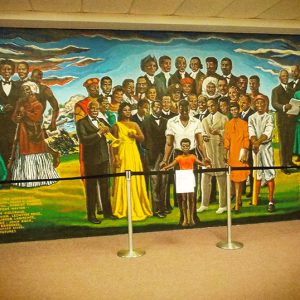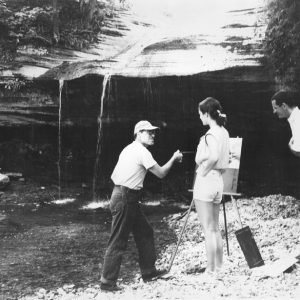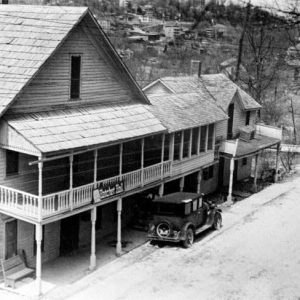calsfoundation@cals.org
Harry Louis Freund (1905–1999)
Harry Louis Freund was a muralist who became famous for his depictions of life in the Ozark Mountains of Arkansas during the 1930s. His artwork is identified with the American scene painters and muralists, such as John Stuart Curry, Grant Wood, and Thomas Hart Benton. He was instrumental in establishing art departments at two Arkansas institutions, Hendrix College and Little Rock Junior College (now University of Arkansas at Little Rock), as well as Stetson University in De Land, Florida. He and his wife, Elsie Bates Freund, founded the Summer Art School in Eureka Springs (Carroll County) and helped shape that resort town as a year-round community for artists and writers.
Louis Freund was born on September 16, 1905, in Clinton, Missouri. His father died while Louis was young. He was inspired to become an artist by his mother, who painted copies of other paintings; an uncle who painted miniature portraits; and a cousin, Evelyn Sturgis.
Freund attended the University of Missouri at Columbia from 1923 to 1925 and Washington University in St. Louis from 1925 to 1929. In 1929, he received the E.H. Wuerpel travel scholarship for one year of foreign travel and study; while in Paris, he studied at the Colarossi Academy and La Grande Chaumiere.
Freund returned to the United States and, from 1930 to 1932, worked as a professional artist in New York City. He found work with the federally supported fine arts section of the Treasury Department and began competing for mural commissions. Freund traveled through the Ozark Mountains of Arkansas and Missouri for months to record the vanishing culture of that area. He painted murals on post office and bank buildings in Heber Springs (Cleburne County), Pocahontas (Randolph County), Eureka Springs, Rogers (Benton County), and Harrison (Boone County), as well as in Florida, Kansas, Oklahoma, Texas, and Missouri. Freund is said to have sent 100 paintings to Washington DC. Freund was also a draftsman, easel painter, and printmaker, and his work followed five broad themes: European landscape, American genre, protest against war, regional landscape, and Christian subject matter. Freund’s style sought for emotional impact in the use of dramatic heavy outlines, somber colors, and compositions with strong diagonal axis. His style in the beginning was light and illustrative and seemed more adventuristic in terms of expression, whereas his later works followed great traditions in artistic styles. As in early Renaissance painting, Freund tended to compress time and space elements in order to capture everything in a cohesive moment—an ability useful in mural painting.
In 1938, Freund was hired as artist-in-residence at Hendrix College in Conway (Faulkner County), where he served as a resident artist until 1941 and as the head of the art department until 1946. He then bought the former home of prohibitionist Carry Nation in Eureka Springs and married artist Elsie Bates there in 1939. They moved into the historic building, where they also established the Summer Art School of the Ozarks.
From 1940 to 1942, Freund was also an artist-in-residence at Little Rock Junior College under the Association of American Colleges, an organization that helped place artists and other figures of the humanities in colleges and universities throughout the country.
Freund was drafted during World War II and served in the Army as a conscientious objector from 1943 to 1945, painting murals for the war department. He spent his time at Camp Pike (now Camp Robinson) in North Little Rock (Pulaski County) and Camp Chaffee in Fort Smith (Sebastian County). The purpose of his murals was to help illiterate recruits learn what they would be doing in the process of Army training. Following the war, he traveled through the Midwest as an itinerant portrait-painter.
A particularly harsh winter inspired Freund to apply for a position at Stetson University in De Land, Florida. In 1949, he became a teacher at Stetson, and from 1951 to 1959, he was chairman of Stetson’s Department of Art. From 1959 to1967, he continued on as Stetson’s artist-in-residence, and during that time, he and his wife spent their summers in Eureka Springs. After retiring in 1967, he worked to establish the Eureka Springs Art Gallery and took an active role in community art projects.
In 1991, Governor William Jefferson Clinton and the Arkansas Arts Council recognized Freund for his “distinguished accomplishments, services and deeds.” In 1995, the Freunds moved to Little Rock (Pulaski County), where he often regaled visitors with stories about his art career. Freund made a great effort to distribute his work to churches and public facilities in his last years. Arkansas institutions that received gifts of his art include the Arkansas Museum of Fine Arts, the Historic Arkansas Museum, the Central Arkansas Library System, University of Arkansas at Little Rock, the University of Arkansas at Pine Bluff, the University of Central Arkansas, Hospice of Arkansas, and the Eureka Springs Historical Museum. In Florida, works went to Stetson University and the DeLand Art Museum; in Missouri, to the Springfield Art Museum, the College of the Ozarks, Central College of Fayette, and the Historic Museum in Clinton.
Freund died on December 22, 1999, in Little Rock and is buried in Eureka Springs.
For additional information:
Louis and Elsie Freund Papers. Special Collections. University of Arkansas Libraries, Fayetteville, Arkansas.
Wolfe, Townsend. “Louis Freund Paintings.” Exhibition Catalogue. Little Rock: Arkansas Arts Center, 1991.
Alan Du Bois
Benton, Arkansas
 Arts, Culture, and Entertainment
Arts, Culture, and Entertainment Calendar Painting
Calendar Painting  Freund Mural
Freund Mural  Louis Freund
Louis Freund  Freunds Dancing
Freunds Dancing  Hatchet Hall
Hatchet Hall 




His 1935 Crossroad Forum is in the 2023 traveling exhibition Southern/Modern organized by Mint Museum. A remarkable painting now seen in Athens, Georgia, that will go on to Nashville, Memphis, and Charlotte. What an impressive Arkansas painter!
My grandfather Raymond Kennon was involved in teaching at Eureka Springs with Louis Freund. I have original cards printed from Mr. Freund titled Seven Stages of Man. These are very relevent to the state of Man today.
I am a graduate of the class of 1976 of Shaw University in Raleigh, NC. Shaw was founded in 1865 by Rev. Henry Martin Tupper, a missionary to the South, to educate sons and daughters of freed African slaves after the Civil War. As a student in the early 1970s, I was impressed by a mural in the library that had a vivid historical narrative. Journalists and visitors to campus often took pictures of the mural. Just yesterday (February 20, 2017), I was in the Shaw University library to take a picture of the mural. The mural tells a story and vital history of the African-American experience. The mural’s historical narrative fits perfectly with a book I am writing to mark 150 years of the university’s educational mission, REVISITING SHAW’S UNIVERSE: FROM AFRICA TO THE AMERICAS. I am going to use a photo of the mural to give substance to the university’s founding roots as an extension of the bigger African and African-American historical context. Yesterday, I saw the artist’s signature and the date of the work: Louis Freund, 1969. The mural is impressive and has maintained photogenic quality for all these years. I wonder how long it took for Mr. Freund to complete this work of perfection. I just learned that he had passed in 1999. I will use this space to thank Mr. Freund and his helpers for a great historical feat. His work speaks for him and his memory lives on at Shaw University. [Editor’s note: See “Freund Mural” photo with the entry.]